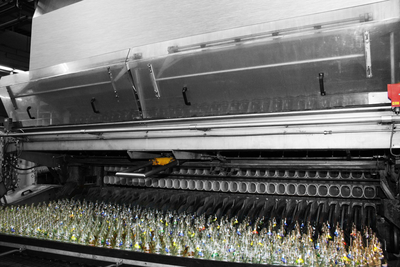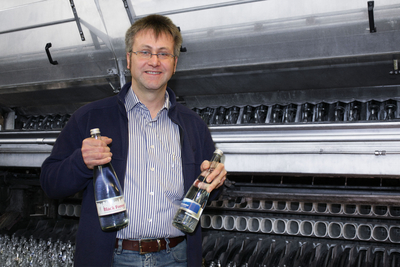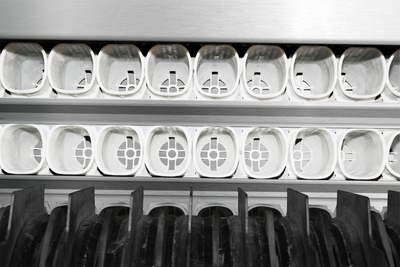
Practically Identical: Investment Costs and Yearly Savings
Peterstaler Mineralquellen opts for innovative KHS energy-saving bottle carrier concept to replace KHS bottle washer in operation for many years
Jan-Karl Nielebock**
Traditionally, KHS AG is an internationally active turnkey supplier of filling and packaging equipment for the beverage, food, and non-food industries. KHS has earned the name "turnkey supplier" not only because it provides turnkey lines on request and also all line components as a one-stop shop concept, but also because it offers a full package of services that is hard to beat. With its Life Cycle Solutions, KHS is able to give companies in the beverage, food, and non-food industries all-round service that leaves nothing to be desired. Life Cycle Solutions fully corresponds to the life cycle of a filling and packaging line and is divided into four areas: idea finding, investment, operating phase, and deinvestment. The clear objective of Life Cycle Solutions is to achieve ceaselessly efficient and economic operation of plant equipment throughout its entire life cycle. Let's take a look at the operating phase, for example. As part of Life Cycle Solutions, KHS specialists support customers by providing systems and solutions in the areas of Maintenance Services, Parts & Materials, Production Solutions, and Modernization & Upgrades, for example. To be even more specific, under Modernization & Upgrades KHS offers a wide range of conversions and optimization measures, which may become necessary during the life of a machine or line – supplemented by plenty of advice on the subject of production optimization and intralogistics. This article aims to highlight in particular the Modernization & Upgrades part of Life Cycle Solutions. Taking Peterstaler Mineralquellen, a bottler of mineral water in the Black Forest, as an example, it shall be shown just how much companies can gain when they upgrade old technologies to new standards. The following focuses on the conversion of a 19-year-old single-end Omega Kaskana bottle washing machine to the innovative and patented KHS energy-saving bottle carrier concept. Six months after the completion of all conversion measures, Engineering Manager at Peterstaler Mineralquellen Wolfgang Sum says, "In view of the experiences we have made, we would repeat the process at any time. On the whole, we were able to make even more savings than KHS originally predicted. And for a mineral water company that sets such high standards as Peterstaler – and this is a deciding factor – the cleaning results are still top, despite the considerable reduction in costs."
* Product Management Manager, Cleaning Technology Competence Center, KHS AG, Dortmund, Tel: +49 (231) 569-1340
Conversion catalog offers plenty of opportunity
Generally speaking, it is KHS policy to fully inform companies in the beverage, food, and non-food industries as to the possible conversions and modifications available for technical systems that have been in operation for many years. In order to give the industry an overview of the most important conversion options for individual machines and complete lines, KHS has developed a conversion catalog that is made available to interested companies. This conversion catalog describes conversion projects already completed and gives the results these have achieved. It provides companies with ideas as to which conversions are feasible for their particular machinery and the results these could yield. As the conversion catalog is conceived as a loose-leaf system, (these can be downloaded off the Internet at http://www.khs.com/website.php?id=/de/publikationen/umbautenblaetter.htm), it can be updated at any time to include the latest conversions and technical innovations.
Individual KHS consultancy service based on fact
KHS always provides companies interested in converting their existing technology with individual consultancy service. This includes a precise analysis of machines and lines that are being considered for conversion. Aspects such as consumption, line efficiency, ease of operation, quality, and much more are taken into account. Based on these facts, KHS then develops suggestions for conversion and describes the effects this would have once conversion has been completed. If required, KHS also helps companies to decide whether to completely reinvest or rather to convert existing machines and/or lines. Besides the costs for conversion or a new investment, a number of additional factors are taken into account, such as the possible remaining service life of existing technical equipment, the flexibility of existing systems regarding new customer requirements, and so on.
Target for Peterstaler Mineralquellen: increase efficiency and save resources – with consistent product quality
At Peterstaler Mineralquellen, investing in new bottle washing equipment was not an option. Sum claims, "In my view, the Omega Kaskana bottle washer is as good as they come. It just keeps on going – as it has done for 19 years with no problems whatsoever." The decisive factor in opting for a conversion was to exploit all possible energy-saving potentials.
Opting for the energy-saving bottle carrier concept
KHS' suggested system involved replacing the steel carriers and steel bottle pockets with energy-saving bottle carriers that are equipped with plastic bottle pockets. The calculated total cost was approximately €100,000. The annual reduction in costs predicted by KHS and generated solely by the use of the new energy-saving bottle carrier concept amounted to around €58,000. This means that the investment will pay off in just under two years. KHS based the above savings possible with the new energy-saving bottle carrier concept on data supplied by Peterstaler Mineralquellen which included the bottle washing machine's average hours of operation per annum, the costs for fresh water and wastewater, for caustics and additives, for defoamers and various other agents, such as acids and chemicals, and the costs for electricity and thermal energy.
Extremely cautious initial calculation for all eventualities
According to Sum, "The result KHS presented us with at first seemed too good to be true. In my own model calculation, I was slightly more cautious and reckoned with an annual saving of just €30,000. I also found this reduction in cost extremely attractive and KHS was thus commissioned with converting our Omega Kaskana to an energy-saving bottle carrier with plastic bottle pockets."
With the new energy-saving bottle carrier concept, Peterstaler Mineralquellen is now well equipped to process 0.25-liter, 0.5-liter, and 0.75-liter glass bottles in the gourmet line for the restaurant and catering trade, plus the 0.5-liter and 0.7-liter GDB bottles used in retail and the green 0.75-liter GDB bottle used among other things for Leopoldsquelle healing water.
Besides the range of glass bottles mentioned above, Peterstaler Mineralquellen has also been using PET bottles since 2000. There are three different sizes currently on the market: the 0.5, 1.0, and 1.5-liter PET bottle. There are, however, two different shapes of bottle in circulation for the company's two brand products – Peterstaler and Black Forest still.
Peterstaler and Black Forest still: two brand names that guarantee quality
Both Peterstaler and Black Forest still are brand names in the high price bracket. Where Peterstaler is largely defined as a regional brand for Baden-Württemberg, Rhineland-Palatinate, Saarland, South Hesse, and for various target groups, since 2008 Black Forest still has been distributed on a national scale and is especially popular with the female target group. Black Forest still has primarily made its mark as a non-carbonated mineral water but also as a still mineral water flavored with natural fruit flavors. According to the company, Black Forest mineral water is particularly gentle and very agreeable thanks to its low level of mineralization – and thus also ideal for the preparation of baby food, among other things. Consumers are just as convinced by the Peterstaler brand – which is slightly different. In 2007, its balanced level of mineralization earned Peterstaler mineral water top marks in the renowned magazine Öko-Test for the fourth time running. Öko-Test described the brand as "one of the highest-quality mineral waters in Germany" and gave it the equivalent of an A grade. In order to be able to supply regional consumers of all ages with the required mineral water products, the Peterstaler range includes not only the Peterstaler classic and Peterstaler medium mineral waters but also a broad spectrum of soft drinks, spritzers, and sports, health, and diet beverages.
Focus on the glass bottle
Even though the percentage of PET bottles used by Peterstaler Mineralquellen is steadily growing, the company's prime focus remains on the glass bottle. This results in a very special task being allotted to the Omega Kaskana bottle washing machine – namely that of ensuring that all glass bottles are perfectly cleaned in accordance with the high demands on quality made by the company brands.
Quality, quality, and yet more quality
"The most important thing for us is that our high product quality is maintained," says Sum. "We would never consider cutting costs if this results in a reduction in quality. We saw the conversion of the Omega Kaskana as a way of guaranteeing top quality while at the same time reducing costs."
Exceptionally quick: conversion in just three days
KHS converted the bottle washing machine to energy-saving bottle carriers with plastic bottle pockets in just three days. On day one, the steel carriers and steel bottle pockets were removed; day two saw the installation of energy-saving bottle carriers equipped with plastic bottle pockets. On day three, the existing caustic was discarded and a new batch was set. "Everything went very quickly," states Sum. "Because we had planned the dismantling and installation of the carriers and pockets from Friday onwards and were active over the weekend, the line downtime hardly made any difference."
Cautious approach to new circumstances
When the line was put back into operation on the Monday, Sum was at first cautious. "For two weeks I used the same amount of water as usual: 365 ml per glass bottle. I then had a feel for the new situation and began testing how much the amount of water could safely be reduced in my opinion while maintaining our high standards of quality."
Up to 50 percent of fresh water saved
The Omega Kaskana has always operated with one stationary and two rotating sprays. The open construction of the energy-saving bottle carrier, Sum thought, could enable not only the rotating fresh water spray to be reduced but also the stationary spray between the pockets to be eliminated. No sooner said than done. Sum cut down on the amount of fresh water used for the rotating sprays and at the same time shut down the stationary spray, then tested the first results. "The cleaning results were perfect," he says. "We didn't register even the slightest alkalinity on the glass bottles. This proved that we were on the right track." In this way, Sum not only managed to achieve the average consumption of 260 ml per glass bottle predicted by KHS, but even attained an impressive 180 ml per glass bottle as well. Sum enthuses "Compared to former fresh water consumption, that's a water saving of 50 percent, with the cleaning quality at least the same – if not better."
Investment costs covered in one year by savings in day-to-day operating costs
The savings Peterstaler Mineralquellen makes per year based on the conversion alone are as follows: water consumption cut by 50 percent, additives by 30 percent, and caustic consumption reduced by 25 percent thanks to the lower carryover.
All in all, this adds up to an annual cut in costs that is about equal to the procurement costs for the new energy-saving bottle carrier concept. This calculation does not include any savings in heat consumption. Sum says "We are bound to make further savings here that I cannot quantify, however, as the bottle washer does not have a separate meter for heat consumption."
The upshot: "You won't save more money any faster than this"
Sum is more than pleased with the results. He clearly states "I never would have thought this possible. My advice to any beverage company facing the decision whether or not to convert to energy-saving carriers is to do so – and as quickly as possible! You won't save more money any faster than this."
Another plus: gentle bottle handling and fast changeover of energy-saving bottle carriers and plastic bottle pockets if required
Besides the advantages of reduced costs, Sum can see a number of other positive aspects that go hand in hand with the energy-saving bottle carrier concept. One of these is the extremely gentle handling of bottles. During the cleaning process, the bottles are always located in the bottle pocket that has been adjusted to fit the largest bottle to be washed. For glass bottles, coming into contact with plastics is much more gentle than direct contact with steel. Glass bottles transported in a steel bottle pocket are susceptible to scuffing and splintering at the bottle mouth, for example. No such risk is posed to glass bottles transported in plastic bottle pockets.
Another considerable benefit is the quick replacement of energy-saving bottle carriers equipped with plastic bottle pockets or of the plastic bottle pockets themselves. The energy-saving bottle carrier equipped with plastic bottle pockets is easily unscrewed and screwed back in place. Because each plastic pocket is fixed in the carrier by a simple snap-on system, any damaged plastic pockets can be replaced within a few minutes. Replacing steel bottle pockets is not quite as easy. Here, the machine has to be stopped and the steel carriers with their integrated steel bottle pockets removed. The damaged steel pocket is then repaired or – if repair is not possible – removed from the carrier and a new steel bottle pocket welded in its place. This is a procedure that can lead to much longer machine downtimes.
Also feasible: the integration of a fresh water controller …
Besides replacing the steel carriers and steel bottle pockets with energy-saving bottle carriers and plastic bottle pockets, Peterstaler Mineralquellen also had the option of integrating a fresh water controller into the washing concept. Fresh water control is useful when there is a variety of different bottles to be cleaned and there are frequent switches between the various types of bottle. The advantage of fresh water control is that the amount of fresh water required for spraying a particular bottle is automatically programmed on selection of the bottle program. What's more, if the bottle washer should be running slowly, the fresh water controller ensures that the amount of fresh spray water is automatically reduced. Sum confirms "For beverage companies that wash a large number of different glass bottles and have to constantly switch between different types of bottle or often run at low output, this is undoubtedly a good thing. As our lines chiefly process the 0.7-liter GDB glass bottle, we didn't think it necessary to incorporate a fresh water controller into our cleaning concept."
… and the pump drive system into the washing concept
However, Sum is interested in another newly developed KHS retrofit. This is what is known as the pump drive system, with the aid of which the frequency control of the spray pumps is constantly geared towards the actual operational status of the bottle washer. Here, the pumps are not switched off should the washer come to a standstill; instead, the pump speeds are greatly reduced. This has the advantage of quickly restarting the bottle washer and rapidly reaching nominal capacity. The first tests reveal that when the pump drive system is used, energy savings of up to 40 percent with centrifugal pumps are quite feasible. Sum says "This sounds excellent – and not just regarding the possible savings in energy. This method is equivalent to an increase in line efficiency, as the time-consuming reactivation of pumps becomes superfluous after a long machine downtime, such as during a coffee break, for example."
Success has many fathers
Sum sees the bottle washing technology situation as follows: "Where there is a chance to cut costs, you should react. Investing in a bottle washer is always just the tip of the iceberg. What really counts over the years and decades is consumption." Sum is reckoning with a second long service life for the Omega Kaskana bottle washing machine. Based on this assumption, he considers conversions that have a payback period of up to five years thoroughly acceptable. "As with the energy-saving carrier concept, we will also study future suggestions for conversion very critically," declares Sum. "When the time comes, we would be happy to let KHS surprise us again. We at Peterstaler Mineralquellen are always open-minded when it comes to innovation. After all, it's this attitude that has made us what we are today – the number one mineral water company in Baden with the strong regional Peterstaler brand and the strong national Black Forest brand that could very probably be destined for an international career. We chiefly owe our success to our ability to see the big picture. And not only with regard to technical systems. Quality, brand policy, technology: for us, these are all linked and when it comes down to it are what contribute to the continuation of the Peterstaler success story."



